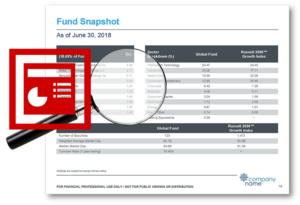Tailored Shareholder Reports: Automation, Business Rules, and Simplicity
’40 Act Funds need a TSR strategy
Find our Tailored Shareholder Report Planning Guide here.
By now, the entire ’40 Act Fund world is aware of the SEC’s new Tailored Shareholder Report (TSR) mandate.
Some questions linger (“What’s the right ‘broad-based index?‘”), but asset managers are making it a high priority to determine their Tailored Shareholder Report implementation strategy and its operating model implications.
Unfortunately, it’s not simply a matter of creating a (massively) shortened annual report – the specifics of the rule mean that new approaches to content strategy, business rules, and related policies and procedures are needed across numerous business functions:
- Fund treasury
- Financial reporting
- Client services
- Legal/compliance
- External service providers and auditors.
View our recorded webinar (8/2/23):
Are Your Systems Ready? 6 Questions to Answer About Implementing the Tailored Shareholder Rule
Same Data, New Use
The TSRs must have access the full spectrum of qualitative and quantitative investment data (e.g.: returns, portfolio characteristics, holdings, etc.) that are generally available to support key sales, marketing and operational requirements throughout the fund’s lifecycle.
Traditionally, factsheets, pitchbooks, websites, investment databases all contain valuable information for investors. High performing asset managers construct these reports with:
- A clear content strategy,
- Automation,
- Business rules to govern data integrity, and
- Design to satisfy both the letter of the law, as well as the eye of the beholder.
We can now throw TSRs into this mix as well!
Fund companies should embrace the TSR mandate and rethink their approach to the entire apparatus surrounding shareholder reporting. By doing so actively and creatively, other data-reliant and data-centric areas can leverage this new integrated approach to improve their effectiveness – and timing – as well.
A solid strategy is essential
Click here for best practices in our Tailored Shareholder Report Planning Guide
Reconfiguring Automation Systems to Leverage the Power of Scale
Our magic equation is: automation = scale = efficiency – it is really that simple.
Automation systems that are effectively designed and properly implemented improve operational efficiencies, reduce costs (opportunity and otherwise), and allow fund management companies to scale up the number of ways in which they can use internal qualitative and quantitative data to their advantage.
New Business Rules for New Regulatory Mandates
We use the term “business rules” to describe the rules or logic applied during the data loading and data rendering stages.
In other words, business rules tell the automation system how to consume and display your data.
But business rules can only be applied after a comprehensive strategy to deliver content, workflow and controls is established.
The best way to plan-out your strategy is to analyze the goals for the TSR, then ask and answer the questions regarding what information should be displayed. For example:
- Which charts and tables appear on your materials?
- Which disclosures are needed?
- Why do some funds show one benchmark index in addition to the broad-based index, and others show just the broad-based index?
Unsurprisingly, the importance of strategy in establishing business rules in automation is thus profound.
If the content strategy and business rules do not exist, the firm’s approach to the TSR could present inconsistent results and harm the firm’s brand. A big benefit of automation is the ability to program these rules into the process, reducing the risk of human error.
It’s Simple: the TSR is a Fund Fact Sheet with Different Facts
The Tailored Shareholder Report is not merely a shortened version of a traditional report – its form and function are much more closely aligned with a traditional fact sheet than anything else.
It stands to reason, then, that extant rules for fact sheet production can strongly influence how the TSRs are conceived, drafted, and ultimately produced.
But what makes automation and appropriate business rules especially salient with the TSRs is the SEC requirement for a separate TSR for each share class.
For a Fund company that has, say 100 funds, each with 5 share classes, that’s 500 discrete TSRs that must be produced semi-annually, complete with iXRBL tagging, ADA compliance, and increased and more complex web-hosting requirements.
And that’s in addition to the normal updates to fact sheets, pitch books, brochures, website, investment databases, required SEC filings, and other digital endpoints.
Viewed from this perspective, a comprehensive content strategy, clearly-defined business rules, workflow and controls and supported by a reliable automation systems are essential.
Easing the Burden on the Fund Treasury Teams
Some of the most important benefits that come from automation and clearly-defined sets of business rules are felt by the fund treasury teams.
The TSR is a mix of qualitative and quantitative datasets. By ensuring that the right quant data pulls from the right places at the right times and populates the TSR correctly (as it does with automated fact sheet production), the treasury team can focus its attention more closely on the qualitative data.
Because areas such as the “Management’s Discussion of Fund Performance” will change meaningfully every reporting period, the ability to rely on the quantitative data population and design being correct is invaluable, as the compliance team can more squarely focus its attention on ensuring the nuances of the qualitative discussions meets the regulatory mandates.
In the end…
After 25 years in the business of automating data-driven sales and marketing collateral for investment management firms, Synthesis is uniquely positioned to assist ’40 Act fund companies to effectively navigate the myriad of strategic and production-related challenges posed by the TSR rule.
Want to learn more?
Read our Tailored Shareholder Report Planning Guide
Here are some related resources that might interest you:







 Compare the Top 3 Finserv Content Automation Vendors [White paper]
Compare the Top 3 Finserv Content Automation Vendors [White paper] Create Pitchbooks the Drive Sales [White paper]
Create Pitchbooks the Drive Sales [White paper] Build vs. Buy: Should Your Financial Services Firm Outsource or Insource Marketing Technology? [White paper]
Build vs. Buy: Should Your Financial Services Firm Outsource or Insource Marketing Technology? [White paper]  10 Tips for Rebranding your Fund Marketing Documents [White paper]
10 Tips for Rebranding your Fund Marketing Documents [White paper]

